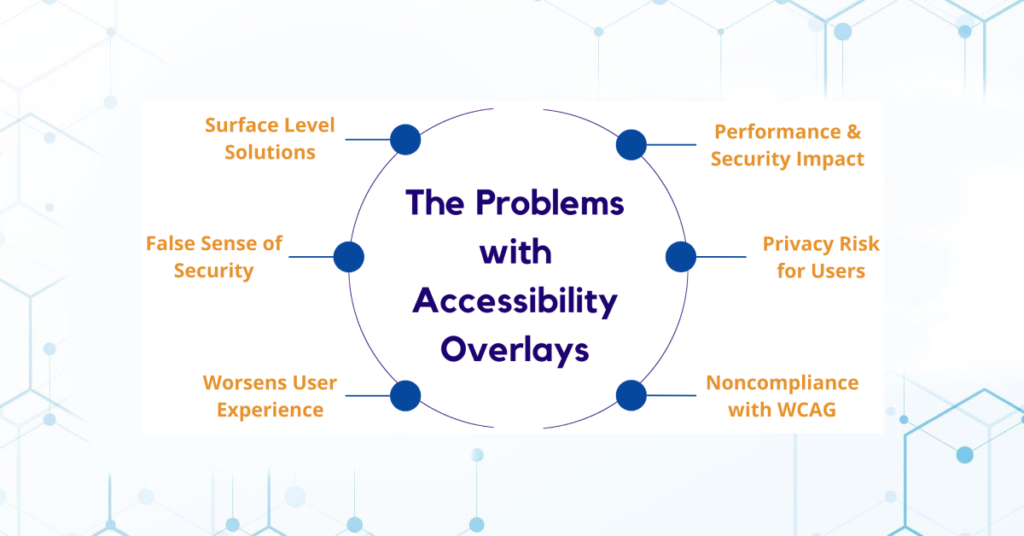Accessibility overlays have become a controversial topic recently. Let’s clarify what they are, how they impact accessibility, and whether you should consider investing in them to meet your accessibility goals.
What are Accessibility Overlays?
Accessibility overlay tools are automated software solutions that claim to identify and address web accessibility issues. These tools operate by altering the code of a web page using a JavaScript code snippet. They are often provided as a toolbar, plugin, app, or widget.
It should be noted that overlays generally do not make changes to the website’s source code. Instead, they focus on identifying basic accessibility issues, such as color contrast and text size, and try to implement necessary adjustments.
The best analogy to understand this would be to think of it like a spell checker. The spell checker is good at doing a certain task, it will most probably take care of all your spelling errors. What it cannot do is edit your document to make it coherent or take care of the sentence structure so that it flows more smoothly.
Why are Accessibility Overlays Gaining Popularity
With a rise in ADA Title III lawsuits (from 2,314 in 2018 to 4,016 in 2022) and high-profile cases like Domino’s and Beyoncé’s company facing legal action, businesses grasp the urgency of website accessibility.
Faced with limited resources and knowledge, they turn to overlays for a quick ADA compliance fix. The appeal lies in the simplicity of inserting a code snippet, promising 100% accessibility.
Overlays Can Cause More Problems Than They Solve
The European Disability Forum (EDF) and the International Association of Accessibility Professionals (IAAP) have released a joint statement, emphasizing the limitations of ‘accessibility overlay’ technology. They caution that this technology does not make websites accessible or compliant with European accessibility standards.
This caution by the EDF runs deeper. On the surface, Accessibility Overlays seem like a promising piece of technology that can make accessibility deployment more convenient and cost-effective for you. However, the reality is these tools offer a narrow solution and fall short of comprehensive compliance.
They try to be a one-size-fits-all solution for all accessibility issues, and this in turn becomes the core of their problem. Digital Accessibility is a dynamic process that needs to have the user at its center, rather than a static problem that can be solved by a line of code.
Moreover, research shows that overlays can only catch 20-30% of accessibility issues and cannot make your website conform to WCAG Level A and AA standards.
The biggest drawback of using an accessibility overlay is the false sense of security it provides. Companies usually feel they have invested in accessibility by getting an accessibility overlay service and are dumbfounded when served with an ADA Lawsuit.

Some other key issues posed by Accessibility Overlays are as follows:
- Interference with User Settings: Overlays can override users’ assistive technology settings, reducing website accessibility and obstructing content access for certain user groups.
- User Inconvenience: Most overlays make the users choose the kind of accessibility support they would like (Blind, Low Vision, Motor Disability, etc.). This makes the user go through unnecessary hassle.
- Redundancy and Replication: Many overlay features duplicate existing mainstream browser and operating system capabilities, offering little value beyond what is already available.
- Tracking and Privacy Concerns: Automatic detection of assistive technology raises privacy issues, particularly if users cannot opt out.
- Lack of Context: Since overlays take care of generic issues, they lack the context that a user might require. This is especially true while providing alt text for images, wherein the software just provides a visual description without providing the necessary contextual information.
What is the Right Approach?
The best practice for making your website accessible in a cost-effective manner is to include the shift left approach. This not only reduces the time required for integrating site-wide accessibility but also saves you money.
If you don’t have in-house accessibility expertise, you can consider hiring an Accessibility Service Provider to help you become accessible. They utilize Automated and Manual testing along with User testing to uncover deep-rooted accessibility issues. This approach ensures that your website becomes fully accessible.
In the end, the journey toward accessibility requires a holistic approach that goes beyond quick fixes, emphasizing education, collaboration, and a commitment to creating digital experiences that cater to the diverse needs of all users.

